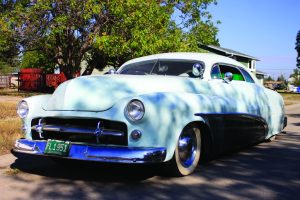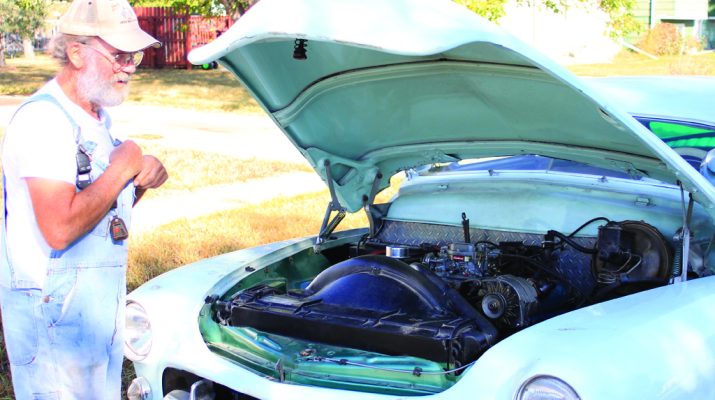Standing in the sun a few weeks ago, I waited by three crates of bricks as traffic stirred up momentary clouds of dirt on the county road. My boss was meeting me there to load the donation from Lynn Finlayson. I began to wonder what project the retired railroader had going on behind his stout fence these days as G.O. arrived with the forklift. It did not take long to put the bricks to use in low spots where water pools by our front door.
A phone message answered my idle curiosity days later. Lynn had asked that I return his call to discuss writing about a car he was working on. I did, and we agreed to meet that Friday morning.
Rounding the corner to Lynn’s house, I spied the sleek two-tone, chopped 1951 Mercury parked across the street. I wanted to find out how much reusing and recycling of parts and materials goes into creating a finished vehicle like this.
Lynn explained the car belongs to his friend Lowell Peterson. “He and I were into custom cars forever. He’s 77 and getting to where he can’t do much.” They found a four-door 1951 Mercury in a field by Scottsbluff. Lynn explained that Lowell wanted a clone of the famous “Hirohata Merc.” That car was originally owned by Bob Hirohata and was the first 1951 Mercury to be chopped as it was transformed by Barris Customs in the early ‘50s. Considered a trendsetter, the car sold for $1.95 million at auction in January.
The tribute to the Hirohata legend, parked on an Alliance street, looked like a quality imitation to me. Lynn said his friend “did all the work himself without hardly any tools,” adding Lowell had spent years patching up cars so they could be sold by car dealers. Lynn is working to get the car running with the help of a guy rebuilding the original carburetor. “He (Lowell) wants to drive it home, I’ll see what I can do,” Lynn said. “This is the ultimate recycling thing.”
From field to finish the classic morphed in many ways. For one, subtract two doors. Another key – find a suitable chassis. Lynn said there is a ‘78 Oldsmobile frame and engine underneath and the car is chopped about four inches. The car retains all the options it had as an Olds. Looking from bumper to bumper: The dash comes from a ‘59 Chevy with seats from something else. A narrower steering wheel stands in for the larger diameter original. Lynn said Buick side chrome is hard to find as he showed how it had been overlapped from a four-door. The back window is from a 1950 Ford and the tail lights are out of a Ford Grenada.

The fact that parts from that many makes and models can be reused to craft something unique speaks to the dedication and passion of this hobby. Lynn has collected, repaired, restored and modified countless vehicles and machines over the decades. Parts, pieces and components fill buildings and storage units. He enjoys going to car swap meets and sells parts from home – most recently to people from Texas and Scottsbluff. Lynn talked about the big meet at Rapid City, S.D., and the expansive Junk Jaunt along Highway 2.
“I get emails all the time looking for parts,” Lynn said. “I did eBay, Craigslist, Facebook marketplace. I have had to deal with scammers. Now I want them to come pick it up, cash only. I started back about 1960.”
Over the years, some of Lynn’s memorable vehicles include a 1929 Studebaker and a 1959 Honda trail bike, the first Honda in town, he added. “My first custom was a 1950 Olds fastback. It had the original V8 automatic. I painted it purple with a paintbrush.”
Recycling car parts helps keep classics and customs on the road instead of rusting into history. Lynn would like to see more interest as the older generation leaves. “Nobody’s going to carry on what we’re doing, like that car (‘51 Mercury) there,” Lynn said. “Like the swap meet up there (Rapid City), same guys up there buying and selling the same parts – no younger people.”

